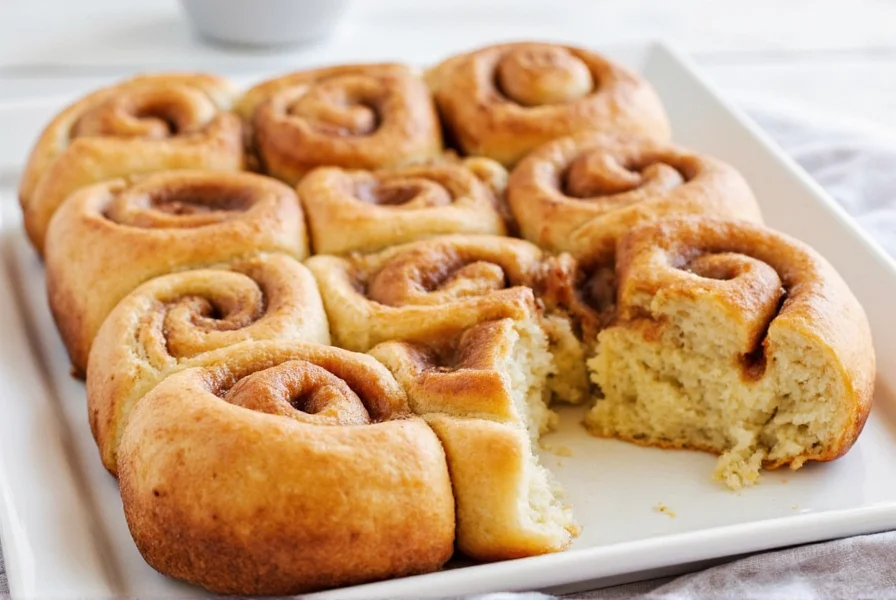If you've ever wondered how to merge two beloved desserts into one showstopper, apple pie cinnamon rolls deliver the perfect marriage of textures and flavors. This innovative pastry has gained popularity for good reason—it offers the comforting warmth of apple pie with the pull-apart satisfaction of cinnamon rolls. What makes this hybrid dessert truly special is how the apple filling complements rather than competes with the traditional cinnamon roll elements.
The Essential Components of Perfect Apple Pie Cinnamon Rolls
Creating exceptional apple pie cinnamon rolls requires understanding both components—the cinnamon roll base and the apple pie filling—and how they interact during baking. Unlike standard cinnamon rolls, the apple component introduces moisture that affects dough texture and baking time.
| Component | Key Ingredients | Critical Considerations |
|---|---|---|
| Dough | All-purpose flour, yeast, milk, butter, sugar, egg | Slightly stiffer than regular cinnamon roll dough to handle apple moisture |
| Cinnamon Filling | Brown sugar, cinnamon, melted butter, flour | Add extra flour to absorb apple juices during baking |
| Apple Filling | Granny Smith apples, lemon juice, sugar, spices | Partially cook apples to reduce excess moisture |
| Glaze | Cream cheese, powdered sugar, apple cider reduction | Balance tartness with sweetness for perfect finish |
Step-by-Step Preparation Guide
The most successful apple pie cinnamon rolls begin with proper apple preparation. Many home bakers make the mistake of adding raw apples directly to the dough, which releases too much liquid during baking and creates soggy rolls. Instead, sauté your diced apples with 1 tablespoon of butter, 2 tablespoons of brown sugar, and 1 teaspoon of cinnamon for 5-7 minutes until slightly softened but still holding their shape.
When rolling out your dough, aim for a 16x12 inch rectangle. Spread the cinnamon-sugar mixture evenly, leaving a 1-inch border, then distribute your pre-cooked apples in an even layer. Roll tightly from the long side, using a sharp serrated knife to cut into 1.5-inch pieces. The tighter your roll, the more defined your swirls will be when baked.

Pro Techniques for Optimal Results
Temperature control proves critical for apple pie cinnamon rolls success. Allow your dough to rise until nearly doubled but not quite – about 75% risen. This gives the rolls room to expand during baking without losing their shape. When proofing the shaped rolls, maintain a warm (80-85°F), humid environment to prevent the dough surface from drying out.
Baking time requires careful attention. Start at 375°F for 15 minutes, then reduce to 350°F for another 10-15 minutes. This two-stage approach ensures the interior cooks through without over-browning the exterior. The rolls are done when they reach an internal temperature of 190°F and the filling bubbles at the edges.
Popular Variations Worth Trying
While traditional apple pie cinnamon rolls use Granny Smith apples, experimenting with different varieties creates unique flavor profiles. Honeycrisp apples add natural sweetness that allows you to reduce added sugar, while Braeburns maintain excellent structure during baking. For a sophisticated twist, incorporate 1/4 cup of bourbon into your apple filling during the sautéing process.
Dietary adaptations work well with this versatile recipe. Gluten-free versions succeed when using a quality 1:1 baking blend with xanthan gum already included. For dairy-free options, substitute plant-based butter and almond milk, adding 1/2 teaspoon of apple cider vinegar to the milk to create a buttermilk substitute.

Serving and Storage Recommendations
Apple pie cinnamon rolls taste best when served slightly warm, allowing the glaze to melt perfectly into the crevices. For optimal freshness, store leftovers in an airtight container at room temperature for up to 2 days. To revive day-old rolls, place them on a baking sheet and warm in a 300°F oven for 8-10 minutes before adding fresh glaze.
These hybrid pastries excel as brunch centerpieces or holiday breakfast specialties. Their combination of familiar flavors makes them particularly appealing for gatherings where you want to impress without overwhelming your guests with unfamiliar ingredients.
Frequently Asked Questions
Can I use canned apple pie filling instead of fresh apples?
While convenient, canned apple pie filling contains too much liquid and added thickeners that can make your rolls soggy. For best results, use fresh apples sautéed with a tablespoon of flour to absorb excess moisture. If you must use canned filling, drain it thoroughly and cook it in a skillet to evaporate excess liquid before using.
How do I prevent my apple pie cinnamon rolls from becoming too moist?
The key to preventing soggy apple pie cinnamon rolls is proper apple preparation. Always sauté your diced apples first to release and evaporate some moisture, and add 1-2 tablespoons of flour or cornstarch to your filling mixture. Additionally, using a slightly stiffer dough than regular cinnamon rolls helps maintain structure when exposed to the apple juices during baking.
What's the best way to slice apple pie cinnamon rolls without squishing them?
Use unflavored dental floss or a sharp serrated knife for clean cuts. For dental floss, slide it under the rolled dough, cross the ends over the top, and pull straight down with even pressure. If using a knife, make sure it's very sharp and use a gentle sawing motion rather than pressing down hard. Chilling the rolled dough for 15-20 minutes before cutting also helps maintain clean layers.
Can I prepare apple pie cinnamon rolls ahead of time?
Yes, you can prepare apple pie cinnamon rolls through the shaping stage, then cover and refrigerate overnight. When ready to bake, remove from the refrigerator 30-45 minutes before baking to take the chill off, then proceed with the recommended baking instructions. You can also freeze fully assembled but unbaked rolls for up to 3 months—thaw in the refrigerator overnight before baking.
Which apple varieties work best for apple pie cinnamon rolls?
Granny Smith apples remain the top choice for their tart flavor and firm texture that holds up during baking. Honeycrisp offers a sweeter alternative with excellent structure, while Braeburn provides a balanced sweet-tart profile. Avoid softer varieties like Red Delicious that turn mushy when cooked. For complex flavor, try combining two varieties—such as Granny Smith and Honeycrisp—in equal proportions.











 浙公网安备
33010002000092号
浙公网安备
33010002000092号 浙B2-20120091-4
浙B2-20120091-4